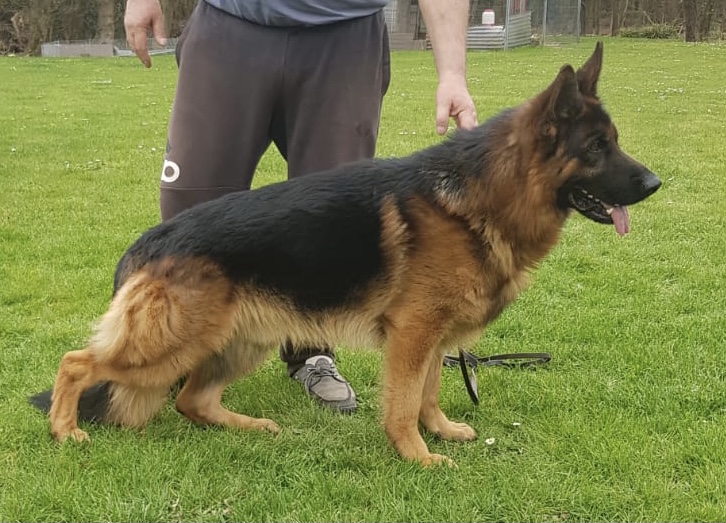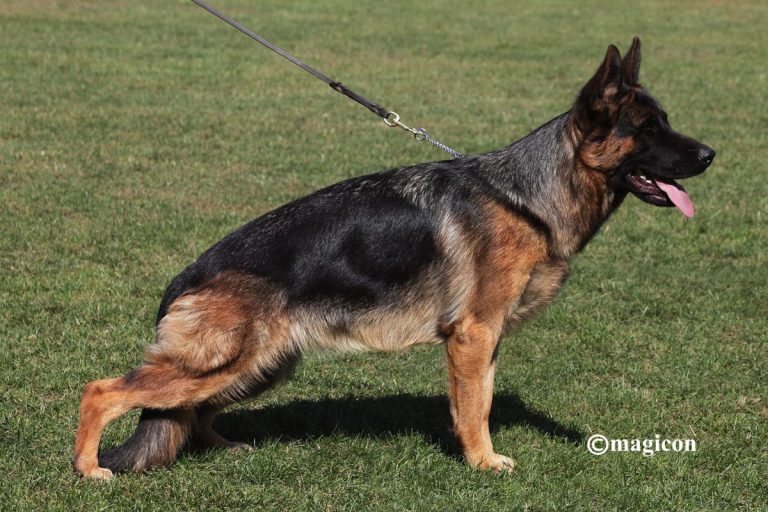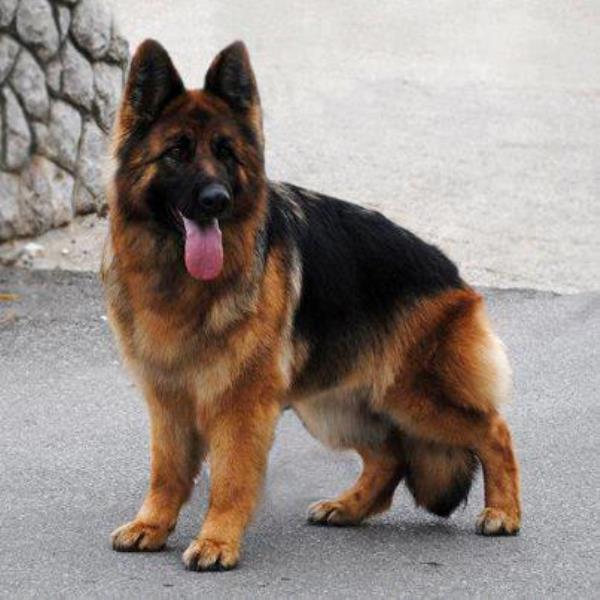We only breed one or two litters a year, male or female puppies should be reserved in advance. Breeding for good temperament and type with over 40 years’ experience. Our dogs are leading the way with excellent conformation and incredible movement without loosing the adorable German shepherd Dog love of family and property. +44 (0)7595 432095 
Meet the Parents
Details on the male and female dogs that have been mated


This is Fantom vom Holtkamper hof, the father of the next litter.
To see the pedigree details of this dog on the German Sheperd Kennel Club click here.

This is Sija vom Holtkämper Hof, the mother of the next litter.
To see the pedigree details of this dog on the German Sheperd Kennel Club click here.
Puppy Development
How puppies develop over the first year of it's life

When you get a 8/12 week old puppy, keep this picture in mind!
His bones don’t even touch yet. They walk very well with large, flexible legs and wobbly movements because their joints are made up of muscles, tendons and ligaments covered in skin. Nothing fits right or has a real grip yet.
When you overwork yourself or don’t restrict your exercise to prevent them from doing too much during this time, it doesn’t give them a chance to grow properly. Every big jump or bounce run causes bone-in shocks. In reasonable quantities, it is not problematic and it is the normal use that every animal is committed to.
But when you let the puppy jump up and down off the living room couch or bed, taking him for long walks or hikes, you damage that joint during training.
A well formed body is something that comes from excellent parenting and upbringing, BOTH, not just one.
Once he grows up, you’ll have the rest of his life to play and do high-impact exercises with him. So keep calm while they are still tiny puppies and give them the gift that can only be given once.
HISPA-NICA.
Useful information for new owners
There are many factors that come into play in the mental and physical health of a dog, but perhaps two of the most important are diet and exercise. Diet and exercise aren’t just important for the high energy performance or working dog. They are key for the average pet dog as well.
Importance of Exercise
Exercise is definitely a very physical activity. It is what builds up stamina, increases physical resiliency and ability, and builds up muscle tone. We also know that exercise helps stave off a chubby puppy.
What many people don’t realize is that exercise is also directly related to a dog’s behavior. When we look at behaviors like hyperactivity, jumping on people, running wild, destructive chewing, digging, running away, excessive barking, etc., these are all annoying behaviors that can often be directly linked to a dog not being exercised enough.
The goal of exercise is for a dog to be happily tired each day. The amount that is required is different for each individual dog. The higher energy the dog has as a base level, the more exercise each dog needs to do.
Exercise should be varied for the best results.The best and easiest way to begin an exercise program is with a general brisk walk, but one can also jog when the dog is an adult dog. Additionally, be creative! Exercise can include tracking activities, Frisbee work, fetch, herding, agility, treadmill work, and water exercise.
An exercise program becomes even more important for a dog geared towards performance or endurance work. These dogs not only need to exercise, but they also need to build up stamina in order to be able to perform over a duration of time. Exercise programs must be slowly increased to build stamina and not over exert the dog.
You must also remember to rotate the type of exercise so as to not accidentally encourage a stress injury in the dog. A dog also needs to have plenty of warm up time to stretch his muscles prior to heavy exercise to avoid injury plus a cooling down time after heavy exercise. Loosely, this means that before your dog does competition height jumps in agility he should warm up with practice jump heights and leg stretches. If you are jogging for two miles with your dog, you should walk the first quarter mile to warm him up and slow to a walk the last half of a mile to cool him down.
The Role of Diet
You are what you eat as the popular expression goes, and it is true for our dogs as well. Diet plays a very important role in our dogs’ lives. It is what nourishes them, gives them the energy to play and work, and keeps them healthy.
There are so many diets available to give our dogs that it can be confusing what is best. You should always read an ingredient label when selecting a food to really find out what is in the food. Ingredients are listed in the order of volume/weight in the food, so it is a good idea to not see grain items or fillers as the first ingredients. Instead, you want to see a meat protein listed first and ideally have a meat protein listed more than once in the top ten ingredients.
Dogs are not obligate carnivores so don’t actually require an all protein/meat diet. Grain free foods are the new popular item in the dog food industry. There is nothing wrong with these foods, but the excess amount of protein is not necessary or fully utilized and could be harmful to an older dog who might have already developed kidney disease.
Foods that have grains in them are not bad foods at all. The main concern is the level of quality of the grains utilized in producing the food. Corn is one example of a very cheap ingredient that many lesser quality foods use to bulk up the food. It is truly used as a filler and has little nutritional value for dogs.
When reading a dog food label you should always ensure that the food meets all nutritional requirements for dogs for the life stage of your dog. Foods geared to All Life Stages must meet the requirements of every age of dog.
Many bags also list the caloric content of the food. If not, a visit to the manufacturer website is a good idea as not all foods are created equal. You might feed two cups of one brand of kibble to equal one cup of kibble from another brand. Additionally, caloric content is important because not all dogs need a higher calorie food. Pet dogs can become fat quickly with too many calories. On the flip side, a performance or working dog easily uses more calories than the average dog, so a food made for high performance dogs with more calories is a good and necessary thing.
Even when using a kibble for the primary part of your dog’s food, you can also add in freshness for variety for your dog. Fresh foods have active enzymes in them that are often missing in cooked or processed kibble. These enzymes are essential for your dog’s health, so fresh vegetables like green beans and carrots add crunch and flavor and lightly boiled fish or chicken add a taste of fresh protein.
The Importance of Socializing Your Dog
The personality of a dog is flexible and indeterminate. Dogs can be exuberant or shy; friendly or hostile; fearful or bold; aggressive or passive or some combination of the above. These differences in personality may to some extent be determined by breed, or individual genetics, but for the most part it is based on how and to what extent each particular dog has been socialized.
So what is socialization? Simply put, this is the process where a dog learns to relate to people, other dogs and other animals based on direct experience. You are certainly aware that the relationship your dog has with you is based on the exposure you have had to each other, and whether or not it has been positive or negative. This same principle extends to the relationship your dog is going to have with other living beings – it is based on both the quality and quantity of his exposure to those beings. The one difference is that while your relationship with your animal is a specific, one-to-one connection, socialization is more general and category-based. In other words, if your dog learns during the socialization process that strangers or other dogs should be met with trust and openness, then he will learn to treat any strangers or dogs he might encounter in the future with the same kind of positive attitude he learned when he was younger.
Socialization begins at Home
It is important that socialization begin early in life. Between the ages of three and twelve weeks, a puppy will be sensitive to socializing experiences, meaning that any positive contacts he has with other living beings will make an impression that lasts into later life. The one problem, however, is that at this age the outside world is still a dangerous place for a puppy. His immunizations have only just begun, and he is not as resistant to potentially deadly infections as he will be later in life. At this tender age, a puppy should be kept in protected environments, meaning basically your home and perhaps your backyard. So, his socialization at this stage will be limited to contact with those beings that are sharing his living space – you, your other family members, and any other dogs, cats or other pets you might have.
Socialization with humans at this stage is relatively unproblematic. Touch him, pet him, hold him, play with him, speak to him in a soft and friendly voice, make sure any strangers who visit either greet the dog in friendship or stay away completely and you should get the desired result – a dog who is generally trusting and friendly with people. If he is part of a litter then he can learn to socialize with other dogs through his siblings and parent; but of course in most instances a puppy will be separated from the litter relatively early, so this kind of natural socialization may not be possible. If there is a cat or other dog in your home when the puppy arrives, the main thing is to make sure that the introductions to these other animals is a very gradual process, so that they can all get to know each other in a completely non-threatening context.
Puppy School
At about the age of three months, your puppy should be ready to leave the house to meet other dogs. Puppy school is highly recommended by veterinarians, dog trainers, and other experts because it will teach young dogs how to relate to others of their own species. The purpose of puppy school is to give your young dog a chance to play with other young dogs of varying breeds, so he will learn to view other dogs as friends, not enemies.
While puppy schools are meant to introduce dogs to other dogs in a positive environment, the also play an important role in the relationship between dogs and human beings. One of the crucial things puppies learn in their interactions with other puppies is bite inhibition. Biting during play is natural and frequent, but what a young dog will learn is that if he bites too hard and causes pain, then the dog he has bitten will not want to play with him anymore, and that is something very bad. Biting etiquette is what we are talking about here, and this is something that will extend into a dog’s relationships with human beings. If there is a neighborhood dog that everyone avoids because he bites, you can be sure that this dog did not get the chance to learn biting etiquette by playing with other dogs when he was younger.
The Importance of Continuing the Process
Socialization begins early in life, but it is a process that can never stop. Dogs enter certain periods of their lives when hostile or fearful behavior can manifest, even if they have been well socialized before. Adolescence is the first such period; around the age of four and a half months (the beginning of adolescence for most dogs), they can go through sudden personality changes, becoming willful and aggressive – just like human teenagers. This is one reason why puppy school should be started after the age of three months, so that your dog will still be there when he enters adolescence and there is the opportunity for skilled trainers to help him get past his anxiety and uncertainness.
Many dog owners have experienced these kinds of personality changes when their dogs are between the ages of eight months and two years. The important point to realize is that the process of socialization must be ongoing and perpetual. You should take your dog into public places, like parks, where he can be exposed to new dogs and people each and every day if possible. You might even want to arrange play dates with other dog owners to make sure your dog continues to have rewarding and fun contacts with other dogs throughout his life.
If your dog starts reacting with hostility to other animals or humans, it is recommended that food be used to help him change those reactions. Give him treats whenever strange dogs, cats, or people approach or visit, so he comes to associate new acquaintances with the pleasures of food. Pretty soon, he will make a connection in his mind and his hostility in the presence of other living beings will turn to feelings of acceptance and welcome.
Socialization is important because it will determine what kind of personality your dog is going to have. You want him to be welcoming, friendly, and trusting; this means you will have an animal companion who is a pleasure to be around, for everyone in the family. It also means you won’t have to worry about getting sued because your dog has been attacking people or their pets. And most importantly, it is what is best for your dog, because a well-socialized dog is a happy dog, and that is what any dog owner should want most of all.
Training Your Dog
For the health and wellbeing of your dog, training should really not ever be considered an option when owning a dog. Well trained dogs are more likely to be behaved and listen, be void of behavioral issues, be good in public, and are less likely to bite. Owners also have a much closer connection with the dog when the time is taken to form a relationship through training.
My Favorite Training Method
There is always more than one way to teach anything, even when we are dealing with human education, and just like with people, every dog is an individual. What might work best for one might not be the very best way to teach another dog the same task. Training should always take into account a particular dog’s temperament, personality, and life experiences.
For example, if I adopt a dog from the local animal shelter that has not been well socialized or has been mistreated, I cannot expect this dog to be at the same starting point in training as a 6 month old puppy with the right upbringing and socialization. I will need to tailor any training program with these differences in mind.
For most every dog, my favorite way to train obedience behaviors is to use the marking behavior system. This system has become increasingly popular in training over the last few decades, and the way most people are familiar with it, even if they don’t know it, is through sea mammal shows like dolphins, killer whales, sea lions, etc. In these performance shows, the trainer uses a whistle to tell the animal when the correct behavior has been performed.
With dogs we often use a tool called a clicker or a verbal marker like the word Yes! This marker is paired up with food for the dog so that each time he hears the click or word, he knows he will receive a treat. More importantly, that marker ends a behavior so he knows exactly the moment he is correct, which lets us do fewer repetitions of a skill and lets him figure it out faster.
Markers are used for teaching new behaviors. Once a dog knows a skill on command (at least 75%-80% reliability), you simply switch over to letting the dog know he did a good job. Markers are also used for testing skills out in new places or if you wish to complicate a skill. It is an excellent style of training for complicated behaviors. For example, when I would teach a service dog to turn on a light switch on a wall, I never took the dog to the wall and assumed he’d know what to do! Instead, this task can be broken down into very easy parts for the dog to learn, and then using the marker I can complicate the task at the dog’s progress rate so that he is less frustrated and still eager to learn.
It is important to develop a style of teaching a dog how to communicate with you. Markers are one such system and truly do help a dog to learn in an efficient method.
Maintaining Behaviors: What Now?
I find that many people worry that using a marker system or using treats in your training leads to a treat dependent dog. This is really a myth. Instead, utilizing food bits for many initial obedience skills is the easiest way to train a dog. Dogs have certain primary motivators (those necessary for life) and food just about tops the list.
That doesn’t mean you use food treats forever. Instead, you gradually create a variable schedule of reward for the dog so that not each behavior receives a treat. Instead, perhaps one skills gets a treat, two times go without a treat, and then the next two behaviors both receive a treat. It’s kind of rewarding like a jackpot machine would. You never know what you’re going to get, but you always have the chance to get something!
Additionally, life rewards become far more important than treats. Some people like to call it Nothing in Life is Free. I tend to think of it more like rewarding a dog with what he likes, wants, and values in life. It teaches him that what he wants is contingent upon his behavior. This is really, really powerful. You are the person that controls all the things your dog wants and needs.
What kinds of things might one use in training? It really depends on the individual dog, but items like toys, his dinner, affection from you, any privilege, or even the door can be used quite well. For example, the door is an excellent reward. It’s not the door the dog wants but what is outside the door (i.e. a walk, playtime, etc.). If a dog knows a skill like Sit or Watch Me, I can ask the dog to perform one of these skills when I am standing at the door with him. If he doesn’t, the door doesn’t open. It’s pretty simple, really.
Most dogs quickly learn how they receive things in life as well as who controls those things. This creates a better listening dog who easily gives you respect because you also respect him. There is never anything mean or punitive involved in this type of system. Instead, I take my offer of the reward off the table if he doesn’t comply.
If my rule is that I ask the dog to Watch Me before I throw a toy and he doesn’t want to, then the game ends by me placing the toy behind my back for a moment. I wait a moment then bring back out the toy and ask again. Nine times out of ten there will be compliance.
Extenuating Circumstances in Training
In my example earlier I noted that not all dogs will train the same, and I can’t expect an older dog with no socialization to train the same way and at the same pacing as a young puppy brought up well. This is very true, and it represents just one extenuating circumstance that can arise in training.
Ideally all dogs would have excellent and correct temperament and be properly socialized. Training would be an absolute snap at that point! Real life often gives us dogs that have less than ideal temperament. Perhaps they are shy, nervous, slightly fearful or perhaps they are sharper in temperament. Sometimes we have dogs that have been heavily influenced by an environment to such an extent as to affect their learning.
There is a learning curve for these dogs, and we have to take that into account when developing a training plan. They can be taught using very similar methods, but often more leeway is necessary when adding in distractions or training away from home. Many dogs under stress may be very well trained at home, but when in a new location that causes stress don’t perform at that same level.
These special dogs take more time to work with and more patience, but they, too, can be trained very nicely. At times I have been blessed (which sometimes feels like a curse!) with dogs that require this extra work to make them blossom fully. It is a rewarding process to train a dog that requires more work and to see what he ultimately becomes.
Final Thoughts
As with all kinds of training, there is always more than one way to do it. I would suggest that the bulk of training should encourage your dog to learn and should be fun. It is important for our dogs to listen to us and to give us respect, but we need to also return the favor.


